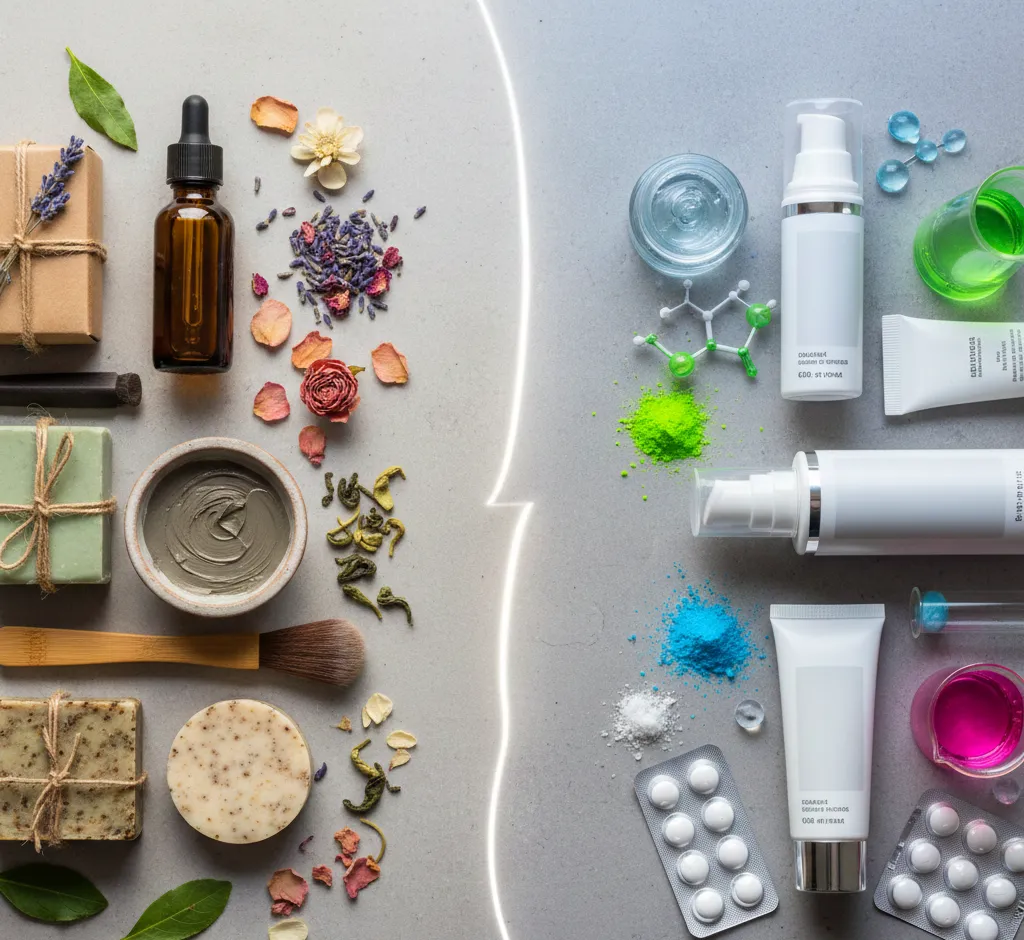The Great Debate: Natural Cosmetics vs. Chemical Alternatives—A Comprehensive Comparison
Explore the comprehensive comparison of natural cosmetics versus chemical alternatives. Learn about ingredient safety, efficacy, environmental impact, cost, and how to choose the right products for your skin and values.

The Great Debate: Natural Cosmetics vs. Chemical Alternatives—A Comprehensive Comparison
In today's fast-evolving beauty landscape, consumers are faced with a fundamental choice every time they purchase a new product: should they opt for formulations derived from nature or those engineered in a laboratory? The debate between natural cosmetics and chemical alternatives is not just about ingredients; it is a complex discussion spanning efficacy, safety, sustainability, and personal values. Navigating this choice requires a deep dive into what defines each category and how they ultimately impact our skin and the planet.
This comprehensive comparison aims to move beyond simple marketing claims, providing an objective analysis of the core differences, the pros and cons, and the ethical considerations involved in choosing one path over the other. By the end, you'll have the knowledge to make an informed, confident decision that aligns with your specific skincare goals and values.
The Foundational Differences: Source and Definition
To truly compare these two categories, we must first establish clear definitions, as the term 'natural' is often poorly regulated in the cosmetic industry.
Natural and Organic Cosmetics: The Earth-Sourced Option
- Source: Ingredients are derived directly from plant (botanical extracts, essential oils, seed oils), mineral (clays, zinc oxide, titanium dioxide), or sometimes animal (beeswax, honey, lanolin) origins.
- The 'Natural' Promise: These products generally prioritize ingredients in their whole or minimally processed state, focusing on compounds that possess an inherent affinity with the skin's natural structure. The primary goal is to avoid synthetic preservatives, petrochemicals, artificial colors, and synthetic fragrances.
- The 'Organic' Distinction: The term organic goes a step further. An organic certification (e.g., USDA Organic, COSMOS ORGANIC) guarantees that a high percentage of the plant-based ingredients were grown without synthetic pesticides, herbicides, or genetically modified organisms (GMOs). An organic cosmetic product is also, by definition, a natural product.
Chemical and Synthetic Alternatives: The Lab-Engineered Solution
- Source: Ingredients are formulated in a laboratory through chemical synthesis. They can be entirely man-made or chemically modified versions of naturally derived compounds.
- The 'Targeted' Approach: Synthetic ingredients are often created to mimic a natural substance (like a lab-grown hyaluronic acid) or to isolate and stabilize a highly potent active compound that is either difficult to source naturally or unstable in its raw form (e.g., specific retinoids or advanced peptides).
- Consistency and Stability: Lab-controlled synthesis ensures a high degree of purity, consistent potency, and stable formulation, allowing for longer shelf lives and predictable performance.
Ingredient Showdown: Efficacy, Potency, and Absorption
The core of the debate often revolves around which category delivers the most effective results. The answer is nuanced, depending heavily on the specific skincare concern and the concentration of the active ingredient.
🔬 Chemical Efficacy: Speed and Precision
Chemical alternatives excel in providing fast, targeted, and aggressive results for specific, severe skin concerns. This is due to several key ingredients:
- Retinoids (Retinol, Tretinoin): These Vitamin A derivatives are scientifically proven to accelerate cell turnover, reduce fine lines, and treat severe acne more quickly than most natural alternatives. The synthetic process allows for high, stable concentrations.
- Alpha and Beta Hydroxy Acids (AHAs/BHAs) like Salicylic and Glycolic Acid: While these acids can be naturally derived (e.g., from sugar cane or willow bark), the synthetic, lab-controlled versions are often used in higher, precise concentrations for deep exfoliation, treating hyperpigmentation, and clearing pores effectively.
- Engineered Peptides: Short chains of amino acids can be synthesized to deliver highly specific signals to skin cells, such as boosting collagen production or relaxing facial muscles, a function that natural, whole-plant extracts struggle to replicate with the same consistency.
🌱 Natural Efficacy: Holistic and Synergistic
Natural ingredients provide a more holistic, long-term approach to skin health, often working to nourish and support the skin's natural barrier:
- Antioxidant Powerhouses: Ingredients like green tea extract, grape seed oil, and natural Vitamin E are packed with antioxidants that combat free radical damage, a primary cause of premature aging. Their effectiveness often lies in the synergy of multiple beneficial compounds present in the whole extract, rather than a single, isolated molecule.
- Skin Affinity and Absorption: Natural oils (Jojoba, Argan, Shea Butter) have a lipid structure that is highly compatible with the skin’s natural sebum. This allows for excellent penetration and optimal assimilation by the epidermis, leading to lasting hydration and barrier repair.
- Proven Effectiveness: Many natural active ingredients—such as Hydrolyzed Marine Collagen, certain forms of Vitamin C (L-Ascorbic Acid), and natural Hyaluronic Acid (Sodium Hyaluronate)—have been subject to clinical studies that prove their effectiveness is comparable to or even surpasses synthetic counterparts, albeit sometimes working more gradually.
The Safety and Skin Compatibility Spectrum
The perceived safety of cosmetics is the single biggest driver of the natural beauty movement. The belief that “natural is always safe” and “chemical is always dangerous” is, however, an oversimplification.
The Concerns with Chemical Ingredients
Consumers often seek to avoid a handful of controversial, yet common, synthetic ingredients:
- Parabens: Used as preservatives, these have been linked in some studies to endocrine disruption. While regulatory bodies like the EU’s Safety Committee consider them safe at low, permitted levels, public concern has led many brands to go 'paraben-free'.
- Phthalates and Synthetic Fragrances: Often used in perfumes and color cosmetics, phthalates are also flagged as potential endocrine disruptors. Synthetic fragrances are one of the most common causes of skin irritation and allergic contact dermatitis.
- Sulfates (SLS/SLES): These powerful surfactants (cleansing agents) are effective but can strip the skin and hair of their natural oils, leading to dryness, irritation, and damage to the skin barrier, especially in sensitive individuals.
The Chemical Counter-Argument: Modern synthetic ingredients undergo rigorous testing to ensure they are safe at their maximum use limits. The consistency of lab-made ingredients often means less batch-to-batch variation, which can sometimes reduce the risk of unexpected reactions compared to a variable natural extract.
The Reality of Natural Ingredients
While natural products minimize exposure to the controversial synthetics, they are not immune to causing adverse reactions:
- Essential Oils: Used for fragrance and therapeutic properties, concentrated essential oils (e.g., tea tree, lavender, citrus oils) are potent chemical compounds that are among the most common causes of contact allergies, particularly when used undiluted or in high concentrations.
- Variability: The potency and purity of a botanical extract can vary depending on the growing season, harvest method, and processing technique. This natural variability can sometimes lead to inconsistent product performance or unexpected sensitivities.
- Contamination Risk: Because they lack harsh synthetic preservatives, natural products are more susceptible to microbial growth (bacteria, mold, yeast). Effective, natural preservation is more complex and often more costly, which is why brands must be highly transparent about their preservation systems.
Verdict on Safety: For sensitive skin, the gentle, soothing nature of base natural ingredients (Aloe Vera, Chamomile) is generally preferred. For all skin types, patch testing is crucial, as both a synthetic ingredient (like a preservative) and a natural ingredient (like an essential oil) can be an allergen.
Environmental and Ethical Footprint
Beyond personal health, the choice between natural and chemical cosmetics has a significant impact on the environment.
🌍 The Chemical Environmental Cost
- Petrochemical Reliance: Many synthetic ingredients are derived from petroleum, a non-renewable fossil fuel, contributing to carbon emissions and resource depletion during manufacturing.
- Non-Biodegradability: Compounds like silicones, certain microplastics (which are still a major concern in some exfoliating products), and non-biodegradable synthetic chemicals can persist in water systems long after they are rinsed down the drain, harming aquatic life and ecosystems.
- Manufacturing Pollution: The chemical synthesis process for many ingredients is energy-intensive and can release pollutants into the air and water.
💚 The Natural Sustainability Advantage
The fundamental premise of natural cosmetics is sustainability, although this relies heavily on ethical sourcing practices:
- Biodegradability: Plant and mineral-based ingredients break down more easily and fully in the environment, minimizing long-term pollution.
- Sustainable Sourcing: Reputable natural brands prioritize ingredients from sustainable or organic farming practices, which promote soil health, reduce pesticide use, and support biodiversity.
- Eco-Friendly Packaging: The natural and organic movement has pushed for a reduction in environmental impact across the entire supply chain, leading to a much wider adoption of recyclable, biodegradable, refillable, or minimal packaging (glass, recycled plastics, paper).
- Cruelty-Free Commitment: While not exclusive to natural brands, the commitment to natural, plant-based, and mineral ingredients often aligns with a cruelty-free and vegan philosophy, extending the ethical benefits beyond just environmental protection.
Cost, Stability, and Shelf Life
The practical considerations of price and product longevity are often the final factors in a consumer's decision-making process.
💲 Cost Comparison:
- Natural/Organic: Tends to be more expensive. The costs associated with sustainable farming, fair-trade sourcing, high-quality botanical extracts, and obtaining rigorous third-party organic certifications are high and are reflected in the final price.
- Chemical/Synthetic: Generally more cost-effective. Lab-based ingredients can be mass-produced with consistent quality, and the raw material costs are often lower than those for high-grade organic botanicals.
⏳ Stability and Longevity:
- Chemical/Synthetic: Exceptional stability. Synthetic emulsifiers, stabilizers, and potent preservatives ensure products can last for 2-3 years after manufacturing and remain consistent across temperature fluctuations.
- Natural/Organic: Shorter shelf life. Without powerful synthetic preservatives, products can degrade more quickly, typically having a shelf life of 6-18 months after opening. They often require more careful storage (e.g., away from direct sunlight or excessive heat) to maintain their effectiveness and prevent microbial contamination.
Conclusion: Finding Your Personal Beauty Philosophy
The debate between natural and chemical cosmetics is not a battle of good versus evil; it is a question of priorities. Both categories offer incredibly sophisticated, effective products, and many modern, innovative brands are successfully creating hybrid formulations that strategically combine the best of both worlds—using stable, science-backed synthetics where needed (like preservatives or specific peptides) alongside nourishing, eco-friendly natural extracts.
Ultimately, your choice should be driven by a thoughtful assessment of your personal needs and values:
- You have sensitive, reactive skin and wish to minimize exposure to common irritants like synthetic fragrances, harsh sulfates, and petrochemicals.
- Environmental impact is your top priority, and you value biodegradability, sustainable sourcing, and minimal packaging.
- You prefer a more holistic, long-term approach to skin health, focusing on nourishment and barrier support.
- You need fast, targeted results for specific, severe concerns like deep wrinkles, stubborn acne, or hyperpigmentation, using ingredients like prescription-strength retinoids or high-concentration acids.
- Product stability, consistency, and a long shelf life are essential for your lifestyle.
- Budget and wide-scale accessibility are key factors in your purchasing decisions.
The most crucial takeaway is the necessity of reading the ingredient list (INCI). The label 'natural' is a marketing tool; the ingredient list is the truth. Look for certifications, research the active ingredients, and perform patch tests. By becoming an informed consumer, you ensure your cosmetic choices benefit not only your skin but also the environment you care about.


